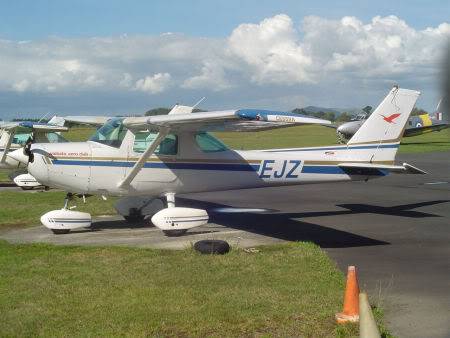Hey everyone,
Last Saturday was lesson number 10, and we were doing 'Circuit Introduction', which turned out to be complete mayhem. I can't be bothered writing put about the theory any more to be honest, and anway the flying itself is what you're reading this for!
Riteo, lets get started. This afternoon I was back with Greg, who I've had a couple of times before. The pre-flight briefing was quite long, as there was about 8 pages of theory in my training manual, but it was quite interesting all the same. Once again we took up ZK-EJZ, my favourite 152 (as well as everyone else). 😉
This time I did the majority of the radio calls on the ground, and I'll go through them here for interest sake.
Myself: Hamilton tower, Echo Juliet Zulu.
Tower: Echo Juliet Zulu, Hamilton tower.
Myself:Echo Juliet Zulu is at the club, request taxi for 30 minutes dual circuits, 2 hours 45 minutes fuel in reciept of Hotel (ATIS) 1008 (Pressure. Note thats the metric system version).
Tower:Echo Juliet Zulu, taxi to holding position Echo 1 for grass 25.
Myself:Echo 1 for grass 25, Echo Juliet Zulu.
--------
Myself:Echo Juliet Zulu is ready.
Tower:Echo Juliet Zulu cleared for takeoff, remain in the circuit (pattern).
Myself:Cleared for takeoff, remain in the circuit, Echo Juliet Zulu.
Finally we took off, and I rotated off the grass and lauched EJZ into the air. Greg flew the first circuit to demonstrate, and that was lucky due to the controller making a number of stuff ups in the circuit. As soon as we turned downwind she requested us to make a right hand orbit, as an Air New Zealand Link Beech 1900D was heading in our direction (well that wasn't really our fault). It was heading for Auckland, where CheekyTrolly lives.😉 Once we turned onto finals for the grass, Greg gave me the controls so I could have a go at the landing, which didn't turn out to bad. Instead of doing a touch and go we were to backtrack along the runway and takeoff again, as a touch and go is fairly high demanding on a learner pilot. The annoying thing about backtracking is you have to turn round on the runway 180 degrees, and taxi all the way back to the threshold (600m :roll🙂which took quite a long time.
Now that we were back at the threshold I finally got to take the controls for the entire circuit, and my first attempt at the circuit wasn't too bad, although I kept turning past my point of reference that I was turning onto when changing from downwind to base legs etc. During the circuit we were forced to change to tarmac 36 (what the heck for I have no idea, most planes were already in the 36 circuit :wall🙂 which annoyed me a bit. Due to high traffic in the circuit ATC decided we would have to do a touch and go, which I was pleased about as I wouldn't be wasting money backtracking.
Turning onto finals we noticed that there were two aircraft sitting on the RWY threshold not looking like they were going anywhere, one sitting behind the other, so we were told to 'go around'. 😂
My approach wasn't exactly spectacular, and it didn't look like much of a straight landing but funnily enough we touched down bang on the centre line (must have been a fluke) 😀. I then brought the flaps back up to the take off setting of 10 degrees, and applied full power for the take off. I still have a slight problem of judging the climb out attitude, but should correct itself with the 5 or 6 touch and goes we will be doing each lesson in the near future.
Unless my memory has failed me I dont think anything out of the ordinary occured that circuit, and we touched back down on 18 for a full stop landing (minding the RWY extension workers just in front of the threshold), and back to the club.
Overall a very intense lesson, the circuit doesn't look very high demanding, but trust me on this one, it is. Not much of time to enjoy the scenery, but still alot of fun.
Lesson Highlight Experiencing one full stop landing, one touch and go landing, one full stop and back track landing, 3 takeoffs, 1 right hand orbit to avoid the Air NZ 1900D, 1 missed approach, and flying the circuits in general - all in just 3 circuits!
Next lesson will be Circuits 1, and we'll probably get through about 5 or 6 circuits depending on how busy the airport is, lets hope not as busy as this lesson! I aplogise if this lesson report doesn't make sense or is all mixed up, I've had to edit its so many times before posting its not funny. 😂
Flying time: 0.8 hrs
Total flying time 6.6 hrs
Until next Saturday (13th May),
Thanks for reading! 😀
 Captain
Captain 38 Answers
38 Answers
 Jump to latest
Jump to latest
 Chief Captain
Chief Captain
 )
)

 First Officer
First Officer
